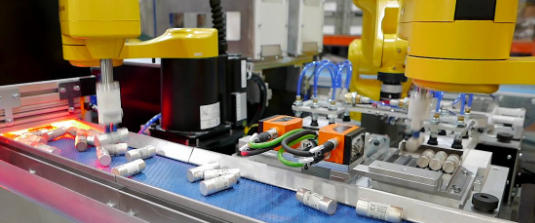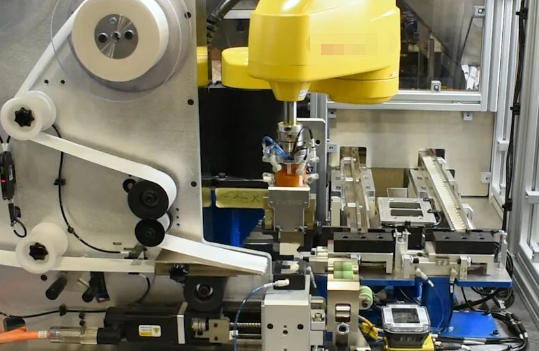Views: 222 Author: Rebecca Publish Time: 2025-11-05 Origin: Site









Content Menu
● What Is an Automatic Feeder System?
● Major Benefits of Automatic Feeder Systems
>> 1. Productivity and Throughput
>> 2. Product Quality and Consistency
>> 4. Enhanced Safety and Cleanliness
>> 5. Flexibility and Adaptability
● Types of Automatic Feeder Systems
● Readiness Checklist: Assessing Your Production Line
● Installation Process: From Planning to Commissioning
● Case Studies: Real-World Implementations
>> Case 1: Bowl Feeder for Medical Device Manufacturing
>> Case 2: Spring Feeding in Component Production
>> Case 3: Safe Feeding in Explosive Environments
>> Case 4: Animal Husbandry—Automating Pig Feeding
>> Case 5: Pharmaceutical Packaging
● Practical Considerations and Potential Pitfalls
● The Future of Automatic Feeding Systems
● FAQ
>> 1. What materials and products can be handled by automatic feeders?
>> 2. How do I determine if my production line truly needs automation?
>> 3. What are typical challenges during feeder system installation?
>> 4. Can feeder systems be integrated with digital factory systems?
>> 5. How quickly can ROI be achieved with automatic feeder systems?
In today's fiercely competitive manufacturing sector, keeping production lines agile, efficient, and scalable is more important than ever. Automatic feeder systems have emerged as a core technology for facilitating these goals, helping companies to boost throughput, increase quality, and reduce labor dependency. However, not every factory or production environment is equally prepared to make the transition to automation. This article guides you through every essential consideration, giving you the clarity to assess your line's readiness and providing actionable insights for successful integration.

Automatic feeder systems are engineered devices that deliver parts or materials onto a production line in a highly controlled, repeatable manner. They range from compact vibratory bowl feeders for small-component assembly, to robotic arms with vision-guided picking, to bulk hoppers managing high-volume bottleneck applications. These systems synchronize with upstream and downstream equipment and, in modern factories, often interface with digital controls and smart factory platforms.
Deploying an automatic feeder can dramatically ramp up production speeds. Unlike manual handling, automated feeders operate consistently around the clock, with many able to feed hundreds or thousands of components per minute. This means fewer pauses, minimized human-induced errors, and seamless transitions between shifts.
One of the greatest weaknesses of manual feeding is variability—it only takes one improperly oriented part or contaminant to degrade the entire batch's quality. Automatic feeder systems are built with tight tolerances, programmable routines, and integrated sensors to ensure only the correct parts are advanced. This improves yield, reduces waste, and safeguards product integrity.
Replacing repetitive manual tasks with automated feeders allows staff to be reallocated to more value-added duties. It minimizes ergonomic strain and injury risks for laborers, reduces human error, and often pays for itself through lowered operational costs.
Automation isolates workers from dangerous apparatus, sharp tools, or hazardous substances. In cleanroom environments or industries like food and pharmaceuticals, feeders also provide closed-system material handling—helping to prevent contamination.
Modern feeders can handle several part formats by simply swapping programs or using tool-free changeover. This is crucial in high-mix, low-volume production environments and supports manufacturers facing frequent batch changes or seasonal demand surges.
Automatic feeders are available in multiple configurations to accommodate specific production challenges. The most common types include:
- Vibratory Bowl Feeders: Ideal for sorting and feeding small, lightweight parts. These use vibration to move and orient parts along a spiral track.
- Centrifugal Feeders: Employ spinning discs to separate and quickly feed symmetrical parts.
- Linear Feeders and Conveyors: Move parts in a straight path, often used for batch counting, labeling, or aligning products for further processes.
- Hopper Feeders: Store and meter-bulk materials or components for regular supply to downstream processes.
- Step Feeders: Lift and gently elevate fragile or irregular objects, minimizing damage.
- Friction and Screw Feeders: Deliver flat items or granular materials with controlled orientation and pace.
- Custom Integrated Systems: Combine multiple feeding technologies, robotics, and sensors for complex or hybrid applications.

Before implementing automation, consider these critical factors:
- Material/Part Compatibility: Are your products suited for automated orientation and handling? Irregular or delicate shapes may need custom feeder solutions.
- Production Volume and Batch Size: High, consistent volumes benefit most. Highly variable products might require flexible or reconfigurable feeders.
- Facility Layout: Space for feeder installation, access for operators, and integration with existing conveyors or robotic equipment.
- Utilities and Controls: Sufficient electrical, pneumatic, and digital I/O infrastructure.
- Staff Training: Operators need training in programming, maintenance, and troubleshooting.
- Digital Integration: For smart factories, compatibility with PLCs, MES, and quality tracking systems.
1. Site Preparation: Clear the installation area, confirm facility readiness for new electrical or pneumatic runs, and ensure adequate space and safety clearances.
2. Mechanical Assembly: Fix the feeder to robust mounts, align with upstream and downstream equipment, and install all guides and tracks.
3. Wiring and Controls: Integrate the feeder's controls with the factory's automation system, connecting sensors, actuators, and data lines.
4. Programming: Set batch parameters, part orientation requirements, error alarms, and safety protocols.
5. Testing and Validation: Run dry and wet cycles to calibrate sensors, check throughput rates, and ensure repeatability.
6. Training: Brief operators and maintenance staff on feeder software, troubleshooting, and cleaning routines.
7. Final Commissioning: Start live operation, monitoring initially for issues, and optimize parameters as needed during ramp-up.
A medical device startup required a high-speed solution to feed metal washers into FDA-regulated assembly lines. By integrating four vibratory bowl feeders with parallel running linear tracks and bulk part hoppers, they achieved an unprecedented throughput of 480 parts per minute. Smart part accumulation buffers and remote filling allowed the lines to operate nearly unattended, optimizing both labor and efficiency. The feeder systems were designed for minimal operator intervention and yielded smooth, high-GMP compliant processes.
A manufacturer specializing in conical metal springs faced tangling problems when feeding parts in bulk. Custom-designed bowl feeders separated and oriented springs, delivering 140 parts per minute directly to the assembly station. This overcame manual untangling and enabled consistent, continuous operation, increasing both throughput and staff satisfaction.
A syringe filling equipment supplier needed a parts feeder that could handle flammable and explosive materials without electric wiring. Specialized mechanical feeding systems (using air-power and antistatic construction) facilitated reliable, contamination-free feeding suitable for explosive atmospheres, supporting regulatory compliance.
A swine operation transitioned from manual to automated feeding and achieved dramatic reductions in feed costs and labor. The precise regulation of schedules and minimized feed wastage meant the system paid for itself in just a few years. Beyond cost savings, animal growth rates and health also improved due to more consistent and palatable feeding patterns. Farm operators also benefited from lighter workloads, more predictable production, and enhanced sustainability.
A friction feeder integrated into a cleanroom packaging system allowed automated counting, verification, and batching of pharmaceutical pouches. With interlocked guards and real-time barcode verification, the solution not only enhanced batch consistency but also guaranteed regulatory safety compliance. Repeat orders from the customer illustrated the long-term value of robust automatic feeding solutions.
- Product Changeovers: Select feeders that allow for quick, tool-less changeovers or programmable adjustments to handle diverse SKUs efficiently.
- Maintenance Requirements: Even the most reliable system will need periodic inspection, cleaning, and occasional replacement of wear parts.
- Supply Chain and Spare Parts: Choose suppliers with responsive service and readily available spare parts to minimize downtime.
- Upfront Investment: Carefully calculate total cost of ownership, factoring in installation, power needs, staff training, maintenance, and downtime savings.
- Change Management: Engaging staff early in automation projects and providing robust training and support helps ensure buy-in and successful transitions.
As Industry 4.0 evolves, feeder systems are increasingly intelligent, with real-time data collection, predictive maintenance, and closed-loop process controls. Advances in robotics and AI-driven vision systems are pushing the boundaries, enabling feeders to handle more complex, delicate, or variable products than ever. Integration with AGVs (Automated Guided Vehicles) and warehouse management further brings seamless “lights-out” manufacturing within reach. Manufacturers investing now in flexible, upgradable feeder technology will be positioned to capitalize on tomorrow's production opportunities.
Automatic feeder systems have become indispensable for manufacturers seeking higher efficiency, quality, and adaptability. They reduce labor dependency, assure consistency, and unlock new levels of scalability for businesses of all sizes. However, successful implementation relies on honest readiness assessment, thorough system evaluation, careful supplier selection, and investment in workforce training and support. By embracing automation and continuously improving processes, your production line can be future-ready for increasing market demands and technological advancement.

Most automatic feeders can be configured to handle a range of materials: loose and bulk parts, rigid and flexible components, powders, small hardware, and even delicate or irregular items. Feeder customization is typically available for complex applications.
If you have consistent high volumes, frequent bottlenecks or downtime, highly repetitive tasks, or face increasing labor costs, automation delivers strong ROI. Additionally, if your quality metrics are suffering due to human variability, a feeder system can help.
Facility space limitations, legacy equipment integration, electrical and pneumatic requirements, staff upskilling, and initial calibration can pose challenges. Proper planning, clear communication, and good supplier support are critical in overcoming these obstacles.
Yes, modern feeders can interface with PLCs, MES, factory monitoring dashboards, and even cloud-based analytics. This means real-time data sharing, smarter controls, predictive maintenance, and better traceability.
Return on investment timelines vary, but many manufacturers report cost recovery within one to three years, driven largely by reduced labor, higher output, fewer defects, and decreased downtime.
Is Your Production Line Ready for An Automatic Feeder System? Find Out Here
What Makes The Automatic Feeder System A Must-Have in Modern Manufacturing?
How An Automatic Feeder System Boosts Precision in Kitchenware Manufacturing?
Automatic Feeder System Buying Guide: Key Considerations for Your Production Needs
The Advantages of Integrating An Automatic Feeder System with Your Existing Machinery
Why Top Manufacturers Choose Automatic Feeder Systems for Their Production Lines?
What To Look for in A High-Quality Automatic Feeder System for Kitchenware Production?
The Future of Cutlery Manufacturing: Why You Need An Automatic Feeder System?
Automatic Feeder System Vs. Traditional Feeding Systems: Which Is Better for Your Factory?
Comparing The Best Automatic Feeder Systems: Features And Benefits
